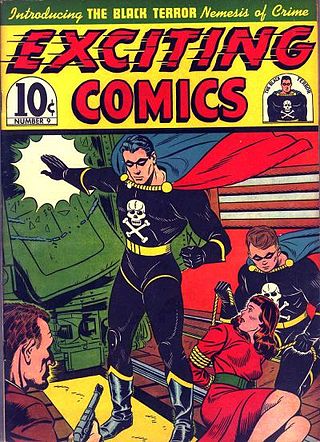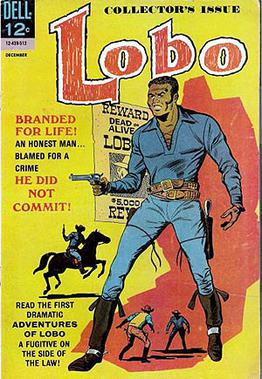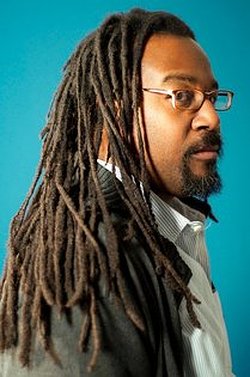
Crispus Attucks was an American whaler, sailor, and stevedore of African and Native American descent who is traditionally regarded as the first person killed in the Boston Massacre, and as a result the first American killed in the American Revolution.

Miss Victory is an American superheroine who first appeared in Captain Fearless #1, published by Frank Z. Temerson's Helnit Publishing Co. Ceasing to be published after 1946, she was revived and updated in 1984 as a central character in the Femforce comic-book series published by A.C. Comics.

Tom Feelings was an artist, cartoonist, children's book illustrator, author, teacher, and activist. He focused on the African-American experience in his work. His most famous book is The Middle Passage: White Ships/Black Cargo.

The Black Terror is a fictional comic book superhero who originally appeared in Exciting Comics #9, published by Nedor Comics in January 1941. The character was popular, and on the strength of the Black Terror's sales, Nedor made Exciting Comics a monthly magazine starting with issue #11.
Anthony F. Tallarico was an American comic book artist, and children's book illustrator and author. Often paired in a team with his generally uncredited penciler, Bill Fraccio, Tallarico drew primarily for Charlton Comics and Dell Comics, including, for the latter, the comic book Lobo, an early comic book starring an African-American.

Lobo is a fictional Western comic book hero who is the medium's first African-American character to headline his own series.

Captain Flag is a superhero created by MLJ Comics' writer Joe Blair and artist Lin Streeter. He first appeared in September 1941, in issue #16 of Blue Ribbon Comics. He continued until the last issue, Blue Ribbon Comics #22.
General Samuel "Happy Sam" Sawyer is a character that appears in American comic books published by Marvel Comics. His first appearance was in Sgt. Fury and his Howling Commandos #1.

Princess Pantha is a jungle heroine that appeared in comic books published by Nedor Comics. The character was revived twice; first by AC Comics, and then by writer Alan Moore for his Tom Strong spin-off, Terra Obscura. She first appeared in Thrilling Comics #56.

The Glyph Comics Awards is an annual award ceremony for comic creators who are people of color. The ceremony was initiated with the goal of inspiring young writers from diverse backgrounds to participate in the comics industry.
Black people have been portrayed in comics since the medium's beginning, with their portrayals often the subject of controversy. Mainstream comic publishing companies have had a historical trend of being predominantly white and male, reflecting the lack of representation and inaccurate depictions of Black people in comics. The integration of black characters in mainstream and superhero comics has endured various obstacles and challenges. Critics have noted that black men and women have historically often been portrayed as jungle or ghetto stereotypes, and as sidekicks as opposed to primary characters. Occiasionally, comic book creators would lampshade stereotypes, lack of representation and emphasize social injustices. In recent years, with the integration of more Black people in mainstream comic writing rooms as well as the creation of comics on digital platforms has changed the representation and portrayals of Black people in comics and has started to reflect the complexities of Black people across the diaspora.
Larry Fuller is an African-American underground comix writer, publisher, and promoter. Along with other such notables as Richard "Grass" Green, Guy Colwell, and Fuller's long-time business partner and friend, Raye Horne, Fuller made sure that the voices of black comic book creators were heard in a time when their artistic efforts were largely ignored. On the topics of race and sexuality, Fuller mastered the art of delivering social commentary in humorous form.

Non-fiction comics, also known as graphic non-fiction, is non-fiction in the comics medium, embracing a variety of formats from comic strips to trade paperbacks.
The East Coast Black Age of Comics Convention (ECBACC) is the Philadelphia region's first black comic book convention, bringing together hundreds of comic book, science fiction, and fantasy creators, their colleagues, and their fans. The ECBACC is a 501 (c)(3) non-profit community-based organization focused on education, literacy and the arts. ECBACC, Inc. was founded in 2002 by Yumy Odom, a multidisciplinary educator, scientist and researcher affiliated with Temple University, and Maurice Waters.
Moira Bertram was an Australian comic book artist and illustrator.

Dan Garret or Dan Garrett is a fictional superhero appearing in American comic books published by Fox Comics, Holyoke Publishing, Charlton Comics, and DC Comics. Garret was created by Charles Wojtkoski, and made his first appearance in Fox's Mystery Men Comics #1 during the Golden Age of Comic Books. Garret is the first character to become the superhero Blue Beetle, predating Ted Kord and Jaime Reyes.

Martin Luther King and the Montgomery Story is a 16-page comic book about Martin Luther King Jr., Rosa Parks, and the Montgomery bus boycott published in 1957 by the Fellowship of Reconciliation. It advocates the principles of nonviolence and provides a primer on nonviolent resistance.

Jamar Nicholas is an African American cartoonist, graphic novelist, and educator based in Philadelphia, Pennsylvania. He is known for original graphic novel, Leon: Protector of the Playground, and his graphic novel adaptation of Fist, Stick, Knife, Gun, a memoir written by African American social activist Geoffrey Canada in 1995. Nicholas's work discusses topics such as bullying and violence while providing alternative, positive portrayals of black individuals.
Joan Bacchus Maynard was an American artist, author, community organizer, and preservationist. She was one of the founding members of a late 1960s grassroots group to preserve the legacy of Weeksville, a pre-Civil War African American community in Brooklyn, New York.
Crispus Attucks Museum is a museum inside Crispus Attucks High School located in Indianapolis, Indiana. The museum is operated by the Indianapolis Public School (IPS) system and features exhibitions on local, state, national, and international African American history.












